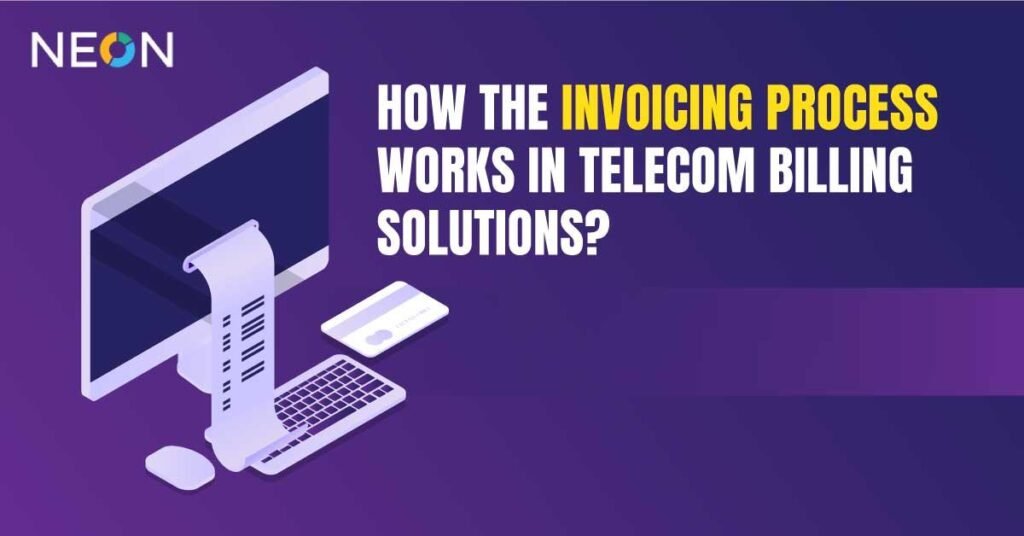Invoicing plays a crucial role in telecom billing solutions, ensuring accurate billing for services provided, maintaining transparency and helping companies manage their financial records efficiently. The process, though intricate, is designed to handle large volumes of data while adapting to various business needs and regulatory requirements. Let’s explore how the invoicing process works in telecom billing solutions, focusing on the steps, tools and key aspects involved.
What are telecom billing invoices?
Telecom invoices are not just simple bills. They cover a wide range of services, including voice calls, data usage, international roaming and even value added services. As businesses and consumers increasingly rely on telecom services, the complexity of billing increases, making the invoicing process an essential part of the telecom billing system. Telecom billing invoices generally include:
- Service usage details (voice, SMS, data)
- Subscription charges for specific plans
- Taxes, surcharges and other regulatory fees
- Discounts, promotions or refunds
- Account balances and payment history
Steps in the telecom invoicing process
The telecom invoicing process follows a structured approach that begins with collecting data and ends with delivering the final invoice to the customer. Here’s a breakdown of the typical steps involved:
1- Data collection
- Service usage tracking
The first step in invoicing is tracking all the services used by the customer. This includes calls made, data consumed, SMS sent and any additional value added services.
- Billing data collection
Telecom billing systems collect this data from various network elements like call detail records (CDRs), usage data records (UDRs) and event data records (EDRs).
2- Data validation
- Error checking
The collected data is validated to ensure there are no discrepancies or errors. Incorrect or missing data can lead to inaccurate billing, so this step ensures data integrity.
- Compliance verification
This stage also ensures that the data complies with regulatory requirements, including tax laws and billing standards in different regions.
3- Rate application
- Pricing plans
Once the data is validated, the billing system applies the relevant pricing plans. This includes per minute charges for voice calls, per megabyte charges for data and any applicable discounts.
- Taxes and fees
Taxes and additional fees are calculated based on the customer’s location and the nature of the service.
4- Invoice generation
- Summary creation
After applying rates, taxes and discounts, the billing system compiles a summary of the customer’s charges, which forms the basis of the invoice.
- Itemised details
Invoices usually include detailed usage information to help customers understand what they are paying for.
5- Invoice review
- Internal audit
Before finalising the invoice, the team conducts an internal review process where they identify and correct any inconsistencies or errors.
- Dispute resolution
If any disputes arise (e.g., if a customer questions a charge), the billing system may flag the issue for further investigation.
6- Invoice delivery
- Digital vs. paper invoices
Once the team finalises the invoice, they deliver it to the customer either electronically (via email, customer portal, etc.) or through traditional mail.
- Payment options
The invoice usually includes details on how the customer can pay, including credit card, bank transfer or other methods supported by the telecom provider.
Types of telecom invoices
There are several types of invoices that a telecom billing system may generate, depending on the services provided and the type of customer. Understanding these different invoices is crucial for both telecom companies and their customers.
1- Prepaid invoices
These are issued to customers who pay in advance for services. The invoice reflects the services they have paid for, such as specific data bundles or calling plans.
2- Postpaid invoices
Service providers bill postpaid customers for services after the customers have used them. The invoice includes a breakdown of all charges incurred during the billing period, including taxes and other fees.
3- One time invoices
For specific services, like the installation of new equipment or a service upgrade, telecom providers may issue one time invoices. These invoices are separate from the regular billing cycle.
4- Recurring invoices
Customers with subscription-based services commonly receive recurring invoices, where businesses bill them on a regular basis (monthly, quarterly, etc.) for ongoing services such as internet access, data plans, or value-added services.
Tools and technologies used in the invoicing process
Modern telecom billing solutions employ various tools and technologies to manage the invoicing process efficiently. Here are some key technologies:
1- Billing software
Telecom companies rely on specialised billing Software that automates data collection, rate application and invoice generation. This software can handle high volumes of transactions and adapt to changing pricing models.
2- Cloud based solutions
Many telecom companies are shifting to cloud based billing platforms, which offer scalability and remote access to billing data. Cloud solutions make it easier for telecom companies to manage large customer bases across multiple locations.
3- CRM integration
Billing systems are often integrated with CRM tools to provide a unified view of the customer’s history, usage patterns, and payment preferences.
To sum up
Customers are billed accurately for the services they use in a complex, multi-step telecom invoicing process. From tracking service usage to generating detailed invoices, telecom billing solutions must handle large volumes of data, calculate rates correctly and ensure compliance with regulations. While challenges such as data management and customer disputes remain, the overall invoicing process is essential for maintaining transparency and trust between telecom companies and their customers.
For Technology related articles, visit Tricksmaza Site.



More Stories
Dental CRM: Building Strong, Lasting Patient Relationships.
How Shopify Themes Influence Store Speed
Best Practices Fantasy Sports App Development